At a glance
Protein is an essential macronutrient that supports muscle growth, hormone balance, and tissue repair. On a keto diet, the best sources of protein are high-quality, minimally processed animal foods that provide sufficient natural fat to sustain ketosis and help maintain balanced blood sugar levels.
Optimal protein intake is vital for maintaining various biological functions, including muscle building, immune function, tissue repair, and hormone synthesis.
Protein is a vital macronutrient, but choosing the right types and consuming the proper amounts is crucial for maintaining health and achieving optimal results while in ketosis.
Discover the best sources of protein on keto, find out how much protein you need, and learn to select high-quality options for maximum benefits.
What is protein?
Protein is one of the three essential macronutrients, alongside carbohydrates and fats. It’s composed of amino acids and found in a wide range of animal- and plant-based foods.
Also known as the body’s building blocks, amino acids are crucial for making new proteins involved in physiological functions such as tissue and bone repair, muscle building, growth and development, and hormone synthesis.
The body can naturally produce 11 nonessential amino acids, but it cannot make the nine essential amino acids, which must be obtained from food sources.
Watch the video below to learn more about the best protein sources.
The importance of protein on a keto diet
Protein is a vital part of any healthy diet, but it becomes especially important on a keto diet, where carbohydrate intake is limited to just five to ten percent of daily calories.
Reducing carbohydrate intake triggers ketosis, a metabolic state that uses stored body fat and dietary fats to generate energy for the cells instead of relying on blood sugar as a fuel source.
If your macronutrients aren’t properly balanced, a protein deficiency could occur, causing the body to break down muscle for energy. On the other hand, excessive protein intake on keto can disrupt ketosis and halt fat burning.
Consuming the right amount of protein is crucial for maintaining lean muscle mass while in ketosis.
How much protein do you need on keto?
Unlike other low-carb eating plans, such as the Atkins Diet, keto isn’t a high-protein diet plan.
On a ketogenic diet, the typical daily calorie distribution consists of 70 percent healthy fats, 20 percent protein, and 10 percent carbohydrates, which helps trigger and maintain ketosis.
Keto dieters are advised to consume between 0.8 and 1.5 grams of protein per kilogram of body weight, which usually translates to 3 to 6 ounces (85 to 170 grams) per meal, depending on their body composition and activity level.
Sedentary individuals should aim for 0.8 grams of protein per kilogram of body weight to support essential bodily functions, while athletes or those with larger body sizes may need up to 1.5 grams to meet their nutritional needs and maintain muscle mass.
However, it’s important to avoid overeating protein to prevent getting kicked out of ketosis.
“Eating too much protein can trigger gluconeogenesis, a metabolic process in which excess protein is converted into glucose,” explains Dr. Berg. “Consuming moderate amounts of protein ensures your blood sugar levels remain balanced, which is critical to maintaining ketosis and fat-burning.”
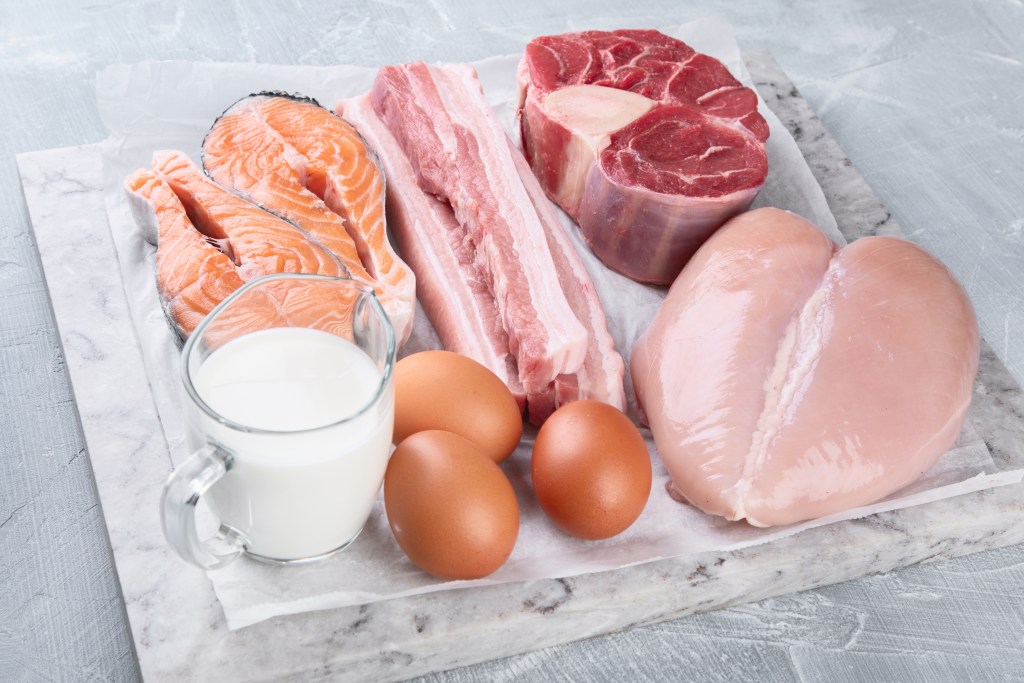
The best sources of protein
While protein can be found in some plant foods, eating meat and animal products is one of the best ways to boost your intake of bioavailable nutrients and meet your daily protein requirements.
Here are six of the top dietary protein sources.
1. Beef
One three-ounce serving of beef offers around 22 grams of complete protein, which means it contains all nine essential amino acids.
Additionally, beef is an excellent source of nutrients, including vitamins A, E, and K, B vitamins, iron, zinc, omega-3 fatty acids, and saturated fat.
Despite the misconception that saturated fat raises cholesterol and the risk of heart disease, saturated fat from animal products isn’t harmful and is necessary to support brain and immune function, hormone synthesis, and skin health.
2. Fish
Fatty fish and seafood are excellent sources of protein. A three-ounce serving of tuna provides 24 grams of protein, while salmon offers 17 grams.
Additionally, fish is rich in anti-inflammatory omega-3 fatty acids, a type of polyunsaturated fat that supports cardiovascular, brain, joint, eye, and skin health.
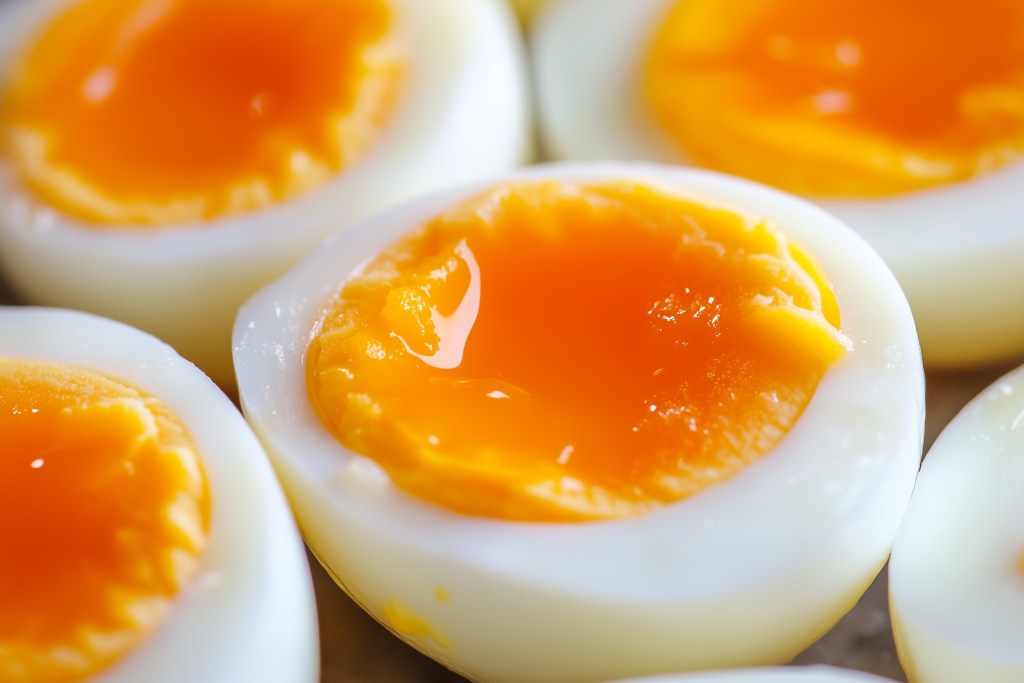
3. Eggs
Eggs are protein-packed superfoods, containing between six to seven grams of protein per large egg. They’re also one of the most nutrient-dense options, as eggs are rich sources of several essential minerals and nearly all vitamins except vitamin C.
Eggs also offer the antioxidants lutein and zeaxanthin, which protect against free radical damage and oxidative stress linked to eye diseases.
4. Poultry
Poultry, such as turkey, chicken, and duck, is another excellent source of protein, with 24, 23, and 16 grams per three-ounce serving, respectively.
Poultry also provides a wide range of B vitamins, iron, phosphorus, choline, and minerals, such as zinc and selenium.
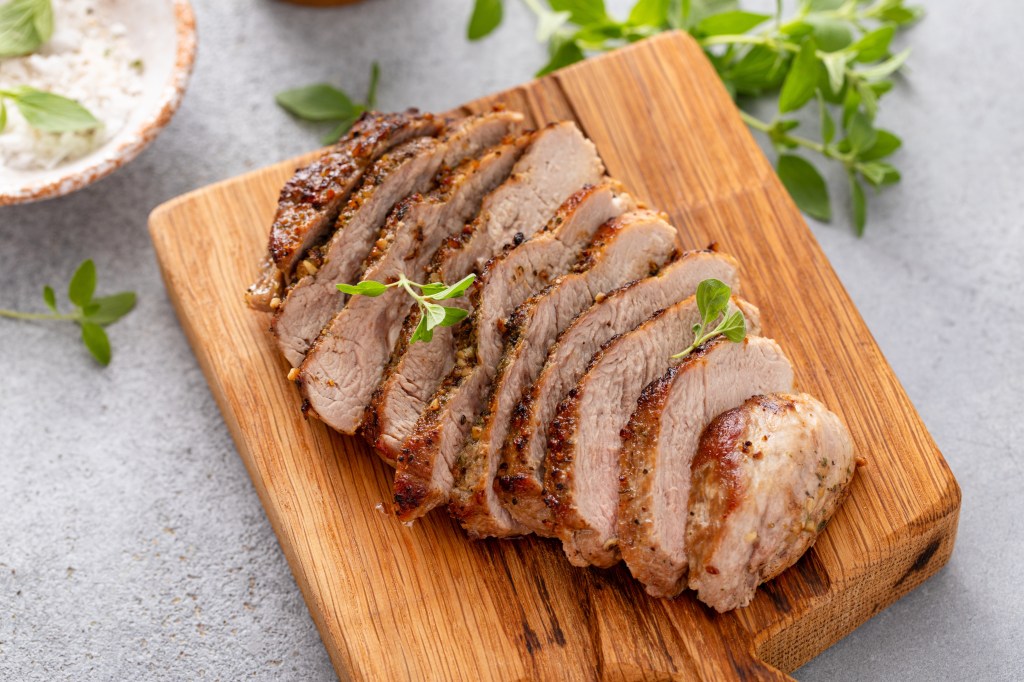
5. Pork
One three-ounce serving of pork tenderloin contains 22 grams of protein.
Fattier cuts, such as pork chops, pork belly roasts, and pork shoulder, are also good options to incorporate to help stabilize blood sugar and insulin levels.
In addition to being a good source of protein, pork is especially rich in B vitamins, which are vital for energy metabolism, nerve function, and cognitive health.
6. Dairy
Dairy products, including whole milk, cheese, and kefir, are excellent high-quality protein options and offer essential fat-soluble vitamins, including vitamins A, E, and K.
Full-fat cheeses such as cheddar, goat cheese, and gouda are ideal for a ketogenic diet as they offer healthy fats and protein while being low in carbs. Just one ounce (28 grams) provides 7 grams of protein.
Kefir, a fermented dairy drink, delivers about 10 grams of protein per cup, along with beneficial probiotics that support a healthy gut.
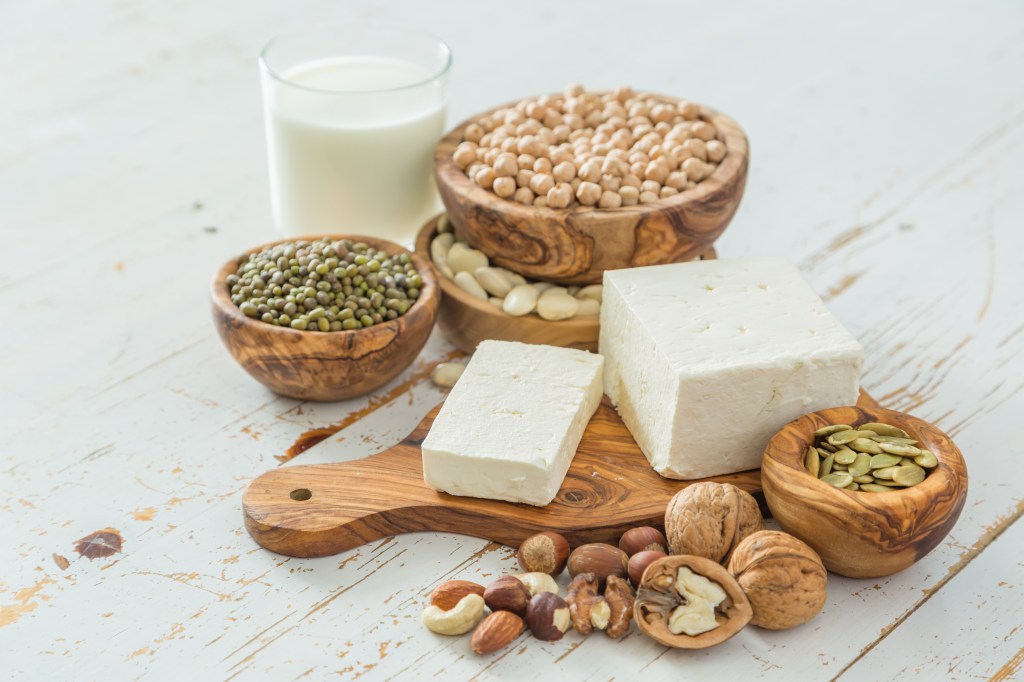
Vegan and vegetarian protein options
While there are healthy protein options for those following a vegetarian or vegan ketogenic diet, they’re generally less abundant than animal-based sources and don’t offer all essential amino acids, making it more challenging to meet the body’s protein needs.
According to a study published in Nutrients, “Plant-based proteins have less of an anabolic effect than animal proteins due to their lower digestibility, lower essential amino acid content, and deficiency in other essential amino acids, such as sulfur amino acids or lysine.”1
However, you can still reap the benefits of ketosis when following a carefully curated plant-based low-carb diet.
Keto-friendly plant proteins include:
- Avocado
- Mushrooms
- Pumpkin seeds
- Sunflower seeds
- Nut and seed butter
- Organic soy products such as tofu and tempeh
- Non-fortified nutritional yeast
- Hummus
- Leafy green vegetables
- Non-starchy vegetables such as broccoli, asparagus, Brussels sprouts, and cauliflower
- Spirulina
Those following a plant-based ketogenic diet should avoid high-carb protein sources such as beans, peas, and lentils, which may inhibit ketosis and interfere with fat-burning.
Additionally, it’s recommended that vegetarians consume protein from high-quality animal sources, such as eggs and dairy, to diversify their protein sources and meet their nutritional needs.
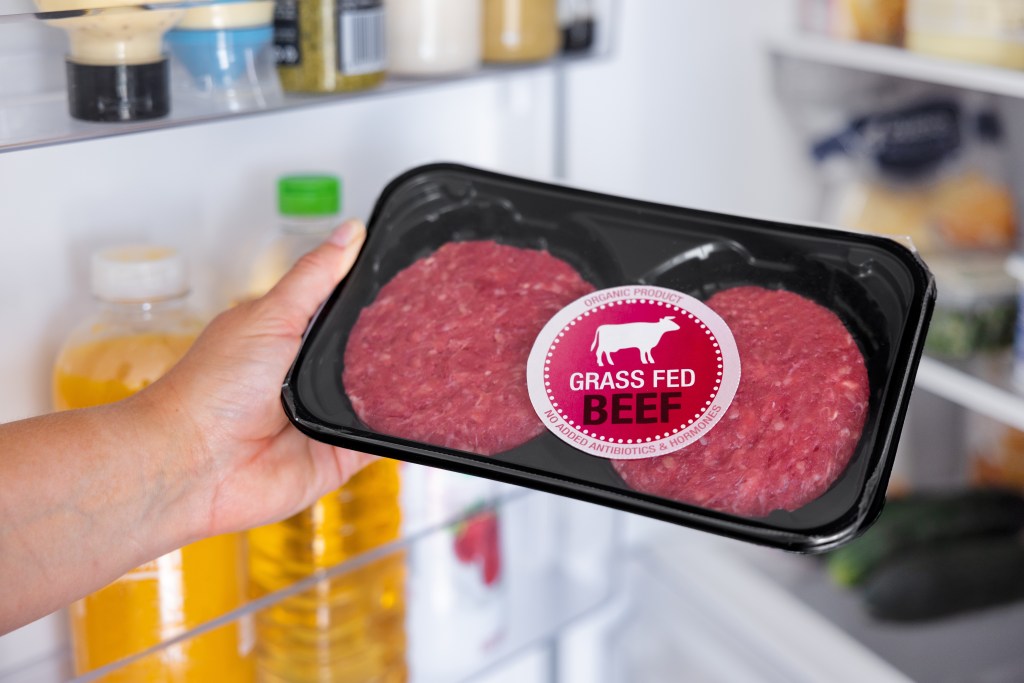
How to choose the best protein sources
Whenever possible, choose animal proteins that are grass-fed, wild-caught, organic, or pasture-raised. Conventional meat, eggs, and dairy often come from animals exposed to antibiotics, growth hormones, and GMO-related toxins such as glyphosate.
Choosing pasture-raised or organic animal products helps minimize exposure to harmful chemicals and offers more complete nutrition. This is largely because the animals are fed higher-quality diets, including grass, natural forage, and non-GMO or organic feed.
A study published in Nutrients found that organic dairy and meat contain higher levels of health-promoting omega-3 fatty acids than conventionally raised products.2
It’s also recommended to choose fatty cuts over lean meat. Fat slows down digestion, which helps buffer the body’s insulin response, stabilize blood sugar levels, increase insulin sensitivity, and promote ketosis.
It’s also important to avoid soy protein isolates and ultra-processed protein sources such as processed meats and many commercial protein powders.
These products are often packed with unhealthy oils and loaded with fillers, hidden sugars, and refined carbs that can spike blood sugar and insulin levels, undermining the benefits of ketosis.
Key takeaways
- Protein plays a vital role in maintaining muscle mass, supporting hormone production, immune function, and overall metabolic health.
- The best sources of protein include beef, fish, eggs, poultry, pork, and full-fat dairy, which supply essential amino acids and healthy fats that help sustain ketosis.
- Plant-based keto options such as nuts, seeds, fermented soy, and non-starchy vegetables can complement animal proteins but offer fewer essential amino acids.
- On keto, aim for about 0.8 to 1.5 grams of protein per kilogram of body weight, or roughly 3 to 6 ounces per meal, depending on activity level and body composition.
- Choose non-GMO, grass-fed, pasture-raised, and wild-caught protein sources whenever possible, and avoid highly processed protein powders or lean-only meats that can disrupt ketosis.
FAQ
1. What are the best sources of protein?
Animal products, such as meat, eggs, seafood, and dairy, offer the most bioavailable protein.
Additionally, plant foods, such as hummus, tofu, and nuts, are also high-protein options and good choices for those following a plant-based ketogenic plan.
2. How do I get more protein in my diet?
Consuming more animal products such as meat, fish, poultry, and dairy can help you meet your daily protein requirements.
It’s recommended that those following a ketogenic diet consume between 0.8 and 1.2 grams of protein per kilogram of body weight, depending on their body composition and activity level.
3. Is it possible to have too much protein in your diet?
Yes, consuming too much protein can interfere with ketosis. When protein intake exceeds the body’s needs, excess amino acids are converted into glucose through gluconeogenesis, which can disrupt fat-burning.
4. Is it more important to have lean protein or high-fat protein?
It’s recommended that keto dieters choose high-fat protein options, which have less impact on blood sugar and insulin levels than lean proteins.
Moreover, the fat content slows digestion and helps keep you feeling full longer, which supports extended fasting periods and provides greater satiety after meals.
5. Are two eggs enough protein for a day?
No, two large eggs contain approximately 12 grams of protein, which isn’t enough for the day. Keto dieters should aim for 3 to 6 ounces (85 to 170 grams) of protein per meal, and many opt to consume four to five eggs daily, along with other protein sources, at their second or third meal.
6. Is red meat bad for you?
No, red meat isn’t bad. It’s a rich source of protein and healthy fats, along with essential nutrients, including iron, zinc, omega-3 fatty acids, and vitamin B12.
However, it’s best to choose organic and grass-fed options to minimize exposure to growth hormones, antibiotics, and glyphosate.
Sources
- https://pmc.ncbi.nlm.nih.gov/articles/PMC6723444/ ?
- https://pmc.ncbi.nlm.nih.gov/articles/PMC7019963/ ?


















